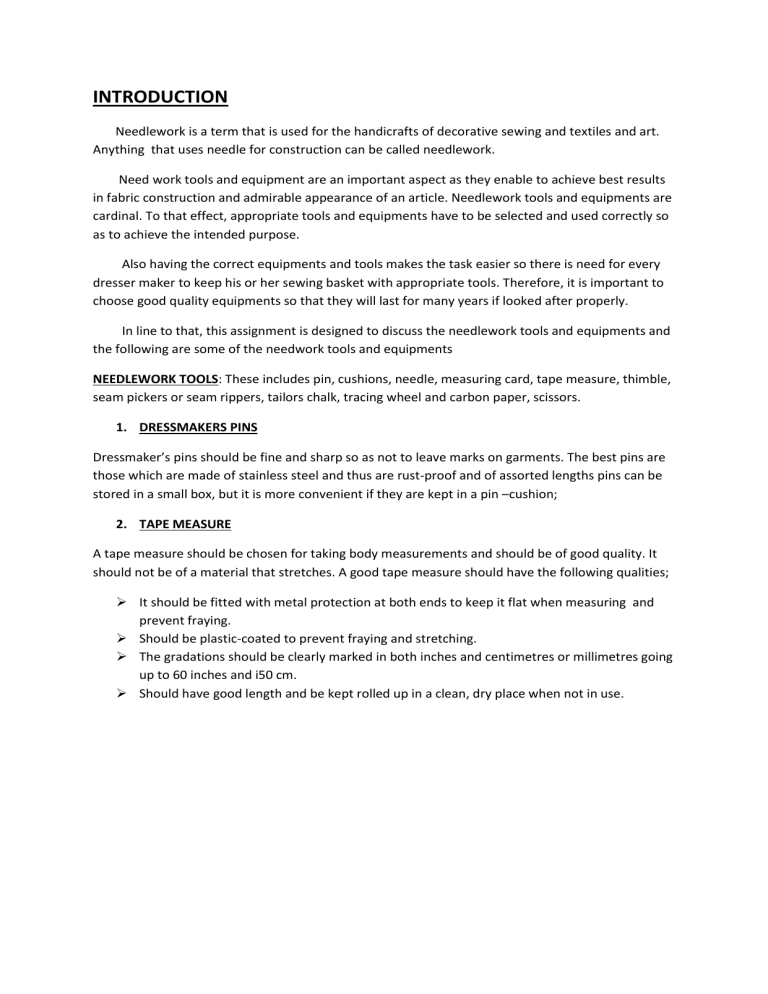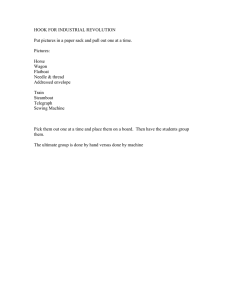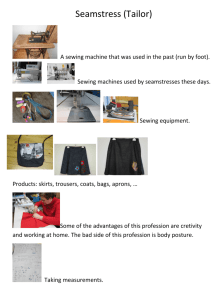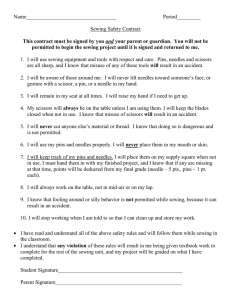
INTRODUCTION Needlework is a term that is used for the handicrafts of decorative sewing and textiles and art. Anything that uses needle for construction can be called needlework. Need work tools and equipment are an important aspect as they enable to achieve best results in fabric construction and admirable appearance of an article. Needlework tools and equipments are cardinal. To that effect, appropriate tools and equipments have to be selected and used correctly so as to achieve the intended purpose. Also having the correct equipments and tools makes the task easier so there is need for every dresser maker to keep his or her sewing basket with appropriate tools. Therefore, it is important to choose good quality equipments so that they will last for many years if looked after properly. In line to that, this assignment is designed to discuss the needlework tools and equipments and the following are some of the needwork tools and equipments NEEDLEWORK TOOLS: These includes pin, cushions, needle, measuring card, tape measure, thimble, seam pickers or seam rippers, tailors chalk, tracing wheel and carbon paper, scissors. 1. DRESSMAKERS PINS Dressmaker’s pins should be fine and sharp so as not to leave marks on garments. The best pins are those which are made of stainless steel and thus are rust-proof and of assorted lengths pins can be stored in a small box, but it is more convenient if they are kept in a pin –cushion; 2. TAPE MEASURE A tape measure should be chosen for taking body measurements and should be of good quality. It should not be of a material that stretches. A good tape measure should have the following qualities; It should be fitted with metal protection at both ends to keep it flat when measuring and prevent fraying. Should be plastic-coated to prevent fraying and stretching. The gradations should be clearly marked in both inches and centimetres or millimetres going up to 60 inches and i50 cm. Should have good length and be kept rolled up in a clean, dry place when not in use. 3. MEASURING CARD This is stiff card made of hard plastic or cardboard. It is very handy in measuring seam allowances and hem depths or measuring short distances. One can be improvised from Manila paper. Lengths on the cardboard should be marked clearly and notched at right angles for easy in marking measurements. 4. SEAM RIPPER An unpicker ( or seam picker) is useful for undoing machines stitches as its steel blade cuts through them easily without damaging the fabric. It has a sharp point for picking out stitches. It can also be used for cutting button- holes using its sharp edge. The ripper should have a cover to protect the sharp edge when not in use. 5. TRACKING WHEEL This is used together with tailor’s chalk, carbon paper in transferring pattern marking on to fabric when using paper patterns. The wheels and handles should be firmly fixed. 6. TYPES OF NEEDLES. A variety of needles should be kept in the sewing kit. There should always be a supply of the various hand-sewing needles and machine needles in the sewing basket Hand sewing needles are available in different sizes and are numbered according to their thickness. A high number means a fine needle where as a low number means a coarse needle. The most useful sizes are 6-9. The following are needles that are commonly used in hand sewing. SHARP NEEDLES: They are of medium size length and have round eyes and are used for ordinary sewing. They can be used on most fabrics. BETWEEN NEEDLES These are short needles and have round eyes but are generally shorter than sharps. Betweens are mainly used for guilting but can also be used in the place of sharps when working with heavier fabrics. DARNING NEEDLES These are long with large eyes for easy threading of wool. Have eyes and are sold in varieties of sizes. Thin ones are used for coarse fabrics while fine ones are for finer material. When choosing needles, one should consider the following ; The needle should be straight and firm. Choose those with smooth and large enough eyes for easy threading. They should be rust free The size should correspond with the weight of fabrics so as not to leave marks. CREWEL OR EMBROIDERY These are embroidery needles with large eyes for easy threading of embroidery thread. They are of the same length as sharp. MACHINE NEEDLE These are available in different sizes according to the fabrics to be stitched. These needles should be stored in a small box or a needle case. 7. TYPES OF SCISSORS The following pairs of scissors are necessary in garment making or construction CUTING-OUT SCISSORS/SHEARS: should have long sharp blades (15-22 cm long) which cut smoothly and evenly. They should be comfortable to hold for example those with plastics handles. These should be used for cutting fabric only, and should be made of rust free material. The blade should be at least 15 cm long. One blade should be narrow, to slip under the fabric and the other heavier, to weigh down the fabric. The handles should have a smaller round hole for the thumb and a large oval hole for the first three fingers. They should be sharp and firmly hinged. The cutting-out scissors must not be used for other purposes, like cutting hair, and should not be dropped. They should be oiled regularly on the hinges and always stored safely after use. BUTTON HOLE SCISSORS: these should have small blades which are sharp and well pointed. These should have small to cut even-sized button holes. EMBROIDERY SCISSORS: These should have fine blades with sharp points for cutting off threads and for close trimming work. They have pointed blades and an easy adjustable screw. They are useful for fine embroidery work and cutting and are also used for snipping and cutting button holes. Embroidery scissors should not be used for cutting hair or finger nails. PINKING SHEARS: These are very heavy scissors with large blades that cut a serrated edge ( zigzag) to neaten the raw edges of a fabric, especially if it frays easily. Pinking shears have the same qualities as cutting out scissors. They are used for cutting and finishing edges of fabrics. NEEDLEWORK EQUIPMENT IRONS These are used in pressing and ironing work in process. Types of iron include charcoal, electric, steam, gas and flat irons. The most commonly used are the electric and charcoal irons. ELECTRIC IRONS They are more convenient to use than flat irons. They only need to be plugged into an electric socket in order for them to heat up, and the temperature is easily and accurately regulated. Thus they can be used on all types of fabric without difficulties. However they are some electric irons which do not have a temperature control knob and therefore need to be carefully as with flat irons. Always switch off an electric iron after use. Do not allow the flex to trail. Keep the flex in good repair never allow the inside wires to be exposed as this is very dangerous. Do not wrap the flex around the iron while it is still hot. Allow iron to cool before storing it. Do not use a knife to remove dirty from the ironing surface as this may damage the mental. To remove burn starch, use brown paper sprinkled with salt or a moist cloth with whitening or vim. Polish the surface with a soft cloth. FLAT(OR SAD IRON) AND CHARCOAL IRONS: Are available in different sizes and are made of polished iron. They can be used where there is no electricity as they are heated on a stove. However, the temperature of these iron s cannot be regulated accurately and thus they are best used in fabrics which are not easily damaged by heat (e.g. cotton) Also several flats will have to be in used at one time as the iron will not cool when they stove. They iron must be picked up using an iron holder ( a padded cloth) as the handle becomes hot. Avoid putting the iron directly on an open fire or gas flames as these will cause the ironing surface to become dirty and roughened. Before using the iron, rub it with fine sand or powdered bath brick, the wipe the surface with a rag and then with another rag wrapped around some candle wax, this will make the iron glide easily over starched items. Lastly, rub well with an old duster. For charcoal iron, ensure that screws are firmly fixed. ELECTRIC STEAM IRON: electric iron which contains water that is that is then heated to produce steam. This steam comes out of holes in the base of iron and dampens the cloth to make ironing easier. The water is poured into the iron through an opening in the tap of the iron. When a steam iron is not in use, any remaining water should be poured out as it may cause the iron to rust on the inside. Other than this, steam irons should be given the same care and cleaning as other electric irons. An iron stand is also needed for putting an iron which is made of galvanised iron AN IRONING BOARD Should be adjusted height to avoid fatigue and poor posture when in use should be well padded and a removovable cover for washing. Square asbestos should be attached for placing the hot iron. It is used for ironing double garments and pleated garments. Bold up the ironing board after use. Keep the cover in good condition and if it is removable, wash it when necessary. Where possible it should have a sleeve board for pressing or ironing sleeves and for pressing small seams and darts. When not in use, it should be folded and stored well. TABLE AND CHAIR These are used by the tailor during the sewing process. The table is used as ironing area or as well as a surface for placing fabrics and drawing or cutting patterns. The chair is sat on by the tailor when making garments. STORAGE FACILITIES These are important for storing garments that is unfinished articles and fabrics. Storage facilities include needlework box drawers, cupboard or ward drops and a dressing mirror or dressing table. These should be made available for storing needle work tools and garments An adequate supply of hangers for both finished and partly finished garments should also be provided. The storage facilities should be clean and the hangers should be rust free and with a smooth surface. THE SEWING MACHINE TYPES OF SEWING MACHINES. A sewing machine is equipment which is very indispensable in any sewing activity, whether it is to be repairing, altering clothes or recycling articles, special care should be given and regular maintenance is needed because it costs a lot when it breaks down. A lot of knowledge of its party and functions will enable you to determine the cause of the trouble when breaks down. There are a wide range of sewing machines available on the market. Sewing machines fall into three categories, namely; hand machines, treadle machines and electric machines. There are those that only make straight stitches while others can be adjusted to sewing their needle zigzagly. These are known as swing needle machines. Although straight stitches are easier for a beginner, swing needle machines have more advantages. This is because they have attachments and built-in devices which help in providing several functions. Such functions include making button holes, darning, edge , finishing, embroidery work, piping, blind Heming etc HAND SEWING MACHINE This is portable and convenient when placed on a table. it is cheaper than treadle or electric machines. However, sewing is slower as only one hand can be used to control the material. Also labour is needed to turn the handle to put the machine into motion TREADLE SEWING MACHINE This is easy to use as both hands are free to control the material being sewn. Hover, it takes up space and cannot be moved easily as it is usually heavy, it is more expensive than a hand sewing machine. Also labour is needed to operate the foot pepal. THE ELECTRIC SEWING MACHINE The electric sewing machines have many advantages. The machine can be portable or fixed to a stand. It leaves both hands of the user free to control the material. No labour is required as the machine is run by electricity. It sews faster than the other two machines. Also, new machines can do a variety of stitches and tasks for example sew on buttons and make button holes. However, it is the most expensive type of sewing machine. PARTS OF THE SEWING MACHINE. It is important to understand the main parts of the sewing machine in order to be able to handle it properly. Good care and maintenance brings about efficiency and long life to the machine. Although there are various models and makes of sewing machines, the main parts and basic principles by which they operate are the same. 1.TREADLE GUIDES It is used to guide the thread from the spool pin through the take-up lever and then to the tention disc and eventually to the needle, keeping the thread tight all the time. 2.TENSION DISC They keep the thread tight stitched and control the feeding of the thread to the needle 3.SPOOL PIN Holds the veal of the top thread. 4. BOBBIN CASE Holds the bobbin and regulates the bobbin thread tension. 5. BOBBIN Holds the botton thread 6.TAKE-UP LEAVE Moves downwards to slacken the thread while the stitch is being formed and moves upwards to tighten the thread when the stitches has been completed 7.NEEDLE BAR The needle is clamped into the needle bar and moves downwards to make top thread through the fabric with every stitch 8. PRESSER Holds the fabric firmly in position during stitching 9.PRESSER FOOT LEVER Raises and lowers the presser foot 9.FEED DOG It is directly under the presser foot and feeds the fabric backwards after each stitch is made 10. THE PLATE Fits around the feed dog and has a hole through which the thread needle passes to form stitches. 11.SLIDE PLATE Covers the bobbin case it is slide open 12. BOBBIN WINDER OR SPINDLE Used to wind the thread around the bobbin 13. STITCH LENGTH REGULATOR Sets the length of the stitches and makes them even and equal in size 14.STITCH WIDTH REGULATOR Sets the width of the zigzag stitch 15.HAND WHEEL AND HANDLE OR HAND Controls the up and down movement of the needle and needle bar 16. HAND WHEEL SCREW (WHICH IS ON THE WHEEL) It stops the needle from moving when loosened and starts it moving again when tightened 17. PRESSURE REGULATOR Controls the pressure of the presser foot CARE AND CLEANING OF THE SEWING MACHINE. 1. Place the machine securely on a table top which is positioned near a window or another source of light if necessary, dust before use. 2. Clean the machine after use by removing any thread which has gathered on the bobbin case holder and plate. 3. Clean the teeth on the gears using a tooth pick to remove or loosen any dirty. 4. Oil all movable parts regularly. 5. Cover the machine when it is not in use and put it in a safe, dry place. 6. The machine should be serviced at least once a year by a good mechanic



